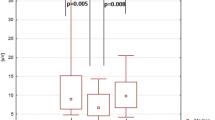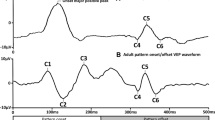Abstract
The diagnosis of albinism can be confirmed by electrophysiological examination, when chiasmal misrouting can be demonstrated. The present study describes a quantitative analysis method for this purpose. A chiasmal coefficient (CC) was calculated by correlating the differential potential over left and right hemisphere, when stimulating left versus right eye. This CC will be negative in albinism and positive in normal individuals. VEPs were recorded in 20 control subjects, four children with congenital motor nystagmus and six children with albinism. In up to 25% of the controls the CC was negative, when using flash VEP. However, with pattern VEP all had a positive CC. All children with albinism had a negative CC. Three of the four patients with congenital motor nystagmus had a positive CC, and one child had a small negative value with flash stimulation. In conclusion, determination of CC is a valuable and objective analysis method for electrophysiological determination of chiasmal misrouting. The method is relatively simple and only needs two electrode tracings. One should be aware of false-positive results when using flash stimulation. Whenever possible pattern stimulation should be used.
Similar content being viewed by others
References
Kinnear PE, Jay B, Witkop CJ. Albinism. Surv Ophthalmol 1985; 30: 75–101.
Guillery R. Visual pathways in albinos. Sci Am 1974; 230: 44–54.
Creel D. Luminance-onset, pattern-onset and pattern-reversal evoked potentials in human albinos demonstrating visual system anomalies. J Biomed Eng 1979; 229: 1395–97.
Apkarian P, Reits D, Spekreijse H, van Dorp D. A decisive electrophysiological test for human albinism. Electroencephalogr Clin Neurophysiol 1983; 55: 513–31.
Fitzgerald K, Cibis, G. The value of flash visual evoked potentials in albinism. J Pediatr Ophthalmol Strabismus 1994; 31: 18–25.
Apkarian P. Practical application of the visual evoked potential in pediatric neuro-ophthalmolgy. In: Vital-Durand F, Atkinson J, Braddick O, (eds) Infant Vision. EBBS Publication Series, Oxford: Oxford University Press 1996: 355–72.
Russel-Eggit I, Kriss A, Taylor DSI. Albinism in childhood: a flash VEP and ERG study. Br J Ophthalmol 1990; 74: 136–40.
Boylan C, Clement RA, Harding GFA. Lateralisation of the flash visually-evoked cortical potential in human albinos. Inv Ophthalmol Vis Sci 1984; 25: 1448–50.
Guo S, Reinecke RD, Fendick M, Calhoun JH. Visual pathway abnormalities in albinism and infantile nystagmus: VECPs and stereoacuity measurements. J Pediat Ophthalmol Strabismus 1989; 26: 97–104.
Apkarian P. Chiasmal crossing defects in disorders of binocular vision. Eye 1996: 10: 222–32.
Ver Hoeve JN, France TD, Spritz R. Hemispheric distribution of VEPs in albinism, aniridia and congenital nystagmus (abstract). 24th Annual Meeting AAPOS 1998.
Soong F, Levin AV, Westall C. Comparison of techniques for detecting visually evoked potential asymmetry in albinism. J AAPOS 2000; 4: 302–10.
Jansonius NM, van der Vliet AM, Cornelissen FW, Pott JWR, Kooijman AC. A girl without chiasma: electrophysiologic and MRI evidence for the absence of crossing optic nerve fibers in a girl with a congenital nystagmus. J Neuro-Ophthalmol 2001; 21: 26–29.
Horton JC, Hoyt WF. The representation of the visual fields in human striate cortex. Arch Ophthalmol 1991; 109: 816–24.
Harding GFA, Boylan C, Clement RA. Visual evoked cortical and subcortical potentials in human albinos. Doc Ophthalmol 1986; 62: 81–88.
Apkarian P, Bour L, Barth PG. A unique achiasmatic anomaly detected in non-albinos with misrouted retinal-fugal projections. Eur J Neurosci 1994; 6: 501–507.
Thompson DA, Kriss A, Chong K, Harris C, Russel-Eggit I, Shawkat F, Neville BGR, Aclimandos W, Taylor DSI. Visual evoked potential evidence of chiasmal hypoplasia. Ophthalmology 1999; 106: 2354–61.
Author information
Authors and Affiliations
Rights and permissions
About this article
Cite this article
Pott, J., Jansonius, N. & Kooijman, A. Chiasmal coefficient of flash and pattern visual evoked potentials for detection of chiasmal misrouting in albinism. Doc Ophthalmol 106, 137–143 (2003). https://doi.org/10.1023/A:1022526409674
Issue Date:
DOI: https://doi.org/10.1023/A:1022526409674




